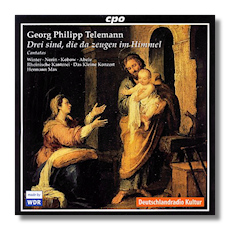
The Internet's Premier Classical Music Source
Related Links
- Telemann Reviews
- Latest Reviews
- More Reviews
-
By Composer
-
Collections
DVD & Blu-ray
Books
Concert Reviews
Articles/Interviews
Software
Audio
Search Amazon
Recommended Links
Site News
 CD Review
CD Review
Georg Philipp Telemann

Cantatas
- Drei sind, die da zeugen im Himmel, TWV 1:377
- Ich hatte viel Bekümmernis, TWV 1:843
- Wie liegt die Stadt so wüste, TWV 1:1629
- Er kam, lobsingt ihm, TWV 1:377 *
Veronika Winter, soprano
Lena Susanne Norin, alto
Jan Kobow, tenor
Ekkehard Abele, bass
* Ingrid Schmithüsen, soprano
* Claudia Schubert, alto
* Howard Crook, tenor
* Gotthold Schwarz, bass
Rheinische Kantorei
Das Kleine Konzert/Hermann Max
CPO 777195-2 DDD 57:08
Many of Johann Sebastian Bach's cantatas are reasonably familiar, of course, but Telemann's are more obscure. One biography credits him with more than a thousand church cantatas, a number that dwarfs Bach's "mere" two hundred or so. For many years he composed two cantatas for every Sunday mass.
Four of those cantatas appear on this CD, which was recorded during the Magdeburg Telemann Festival Days. The first three cantatas (recorded in 2006) follow the expected pattern of alternating arias and recitatives, concluding with a chorale. The fourth (recorded in 1997) is a glorious chain of brief arias for soprano, alto, tenor, and bass, also concluding with a chorale. Telemann's workmanship and imagination remain high in all four cantatas. There are many examples of word-painting. When the text alludes to the course (Lauf) of one's life, the sixteenth notes in the accompaniment depict that course. When the text alludes being laid in the grave, the vocal line sinks; when Jesus rises into heaven, the vocal line soars. Also, Drei sind, die da zeugen im Himmel, a contemplation of the mystery of the Trinity, is filled with musical representations of the number three. The texts, by Erdmann Neumeister, Johann Friedrich Helbig, and Daniel Schiebeler, are also of great evocative power. (Bach also wrote a cantata called Ich hatte viel Bekümmernis, but apart from the opening ensemble, based on a verse from the 94th Psalm, the texts are different.)
Drei sind, die da zeugen im Himmel and Ich hatte viel Bekümmernis date from the second decade of the 1700s, when Telemann had an appointment with the court at Eisenach. Wie liegt die Stadt so wüste comes from 1727, near the start of Telemann's many years in Hamburg, and the forward-looking Er kam, lobsingt ihm is late work, from 1759, when the composer was approaching 80. (Even so, he continued to compose for almost another decade.)
Hermann Max has recorded many of Telemann's cantatas and oratorios, formerly for Capriccio and now for cpo, and it is impossible not to admire the high standards of performance that he has established and maintained. These are historically informed performances that throb with the excitement of the here and now. Max never uses the music as a vehicle for the gratification of his ego, so there's no exaggeration or gratuitousness. His soloists, all experts in the Baroque repertoire, are similarly careful not to confuse character (of which there is plenty) with archness. I slightly prefer the singers in the last cantata, but perhaps that is because the music is also stronger.
The engineering also is particularly fine in the last cantata. Nevertheless, the sound throughout is invigorating and true. Cpo's booklet annotations go into detail about each of the cantatas, but have less to say about Telemann's cantatas in general. Texts and English translations are included. There's no reason not to enjoy every moment of this CD.
Copyright © 2007, Raymond Tuttle




















